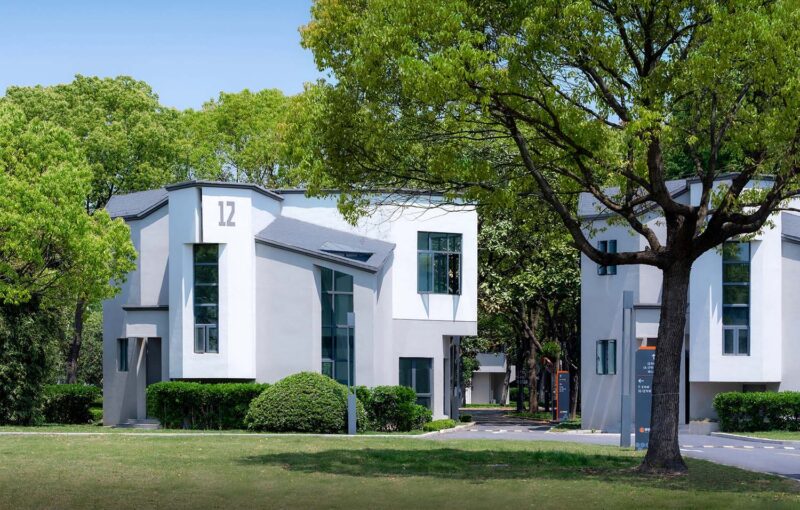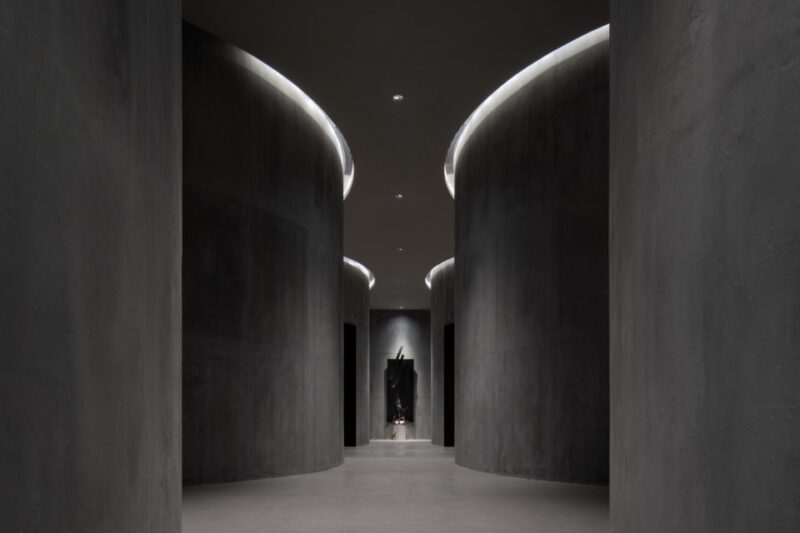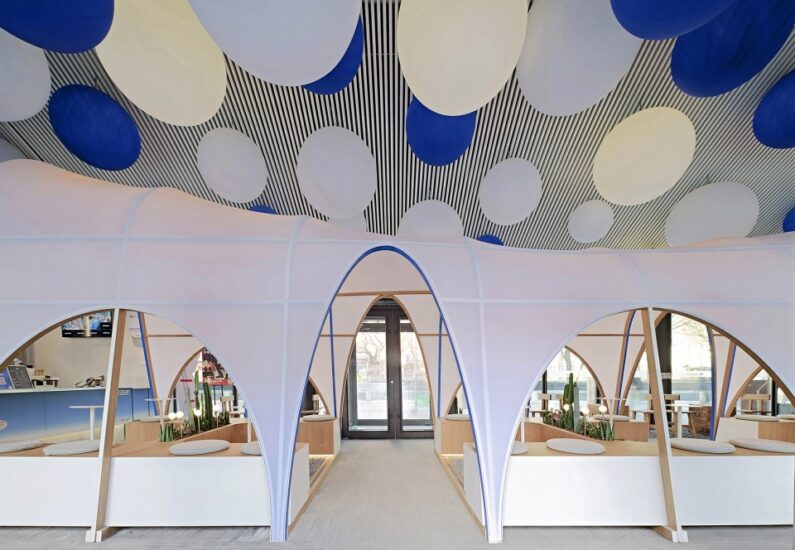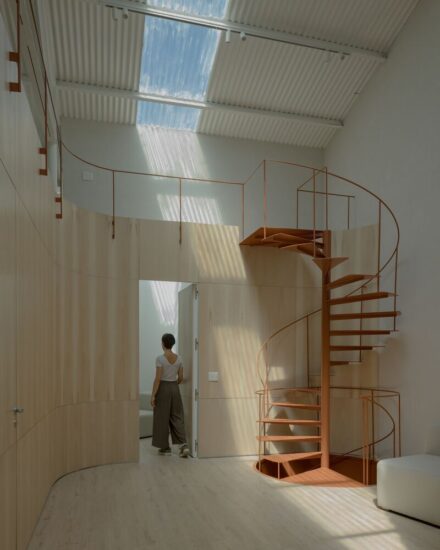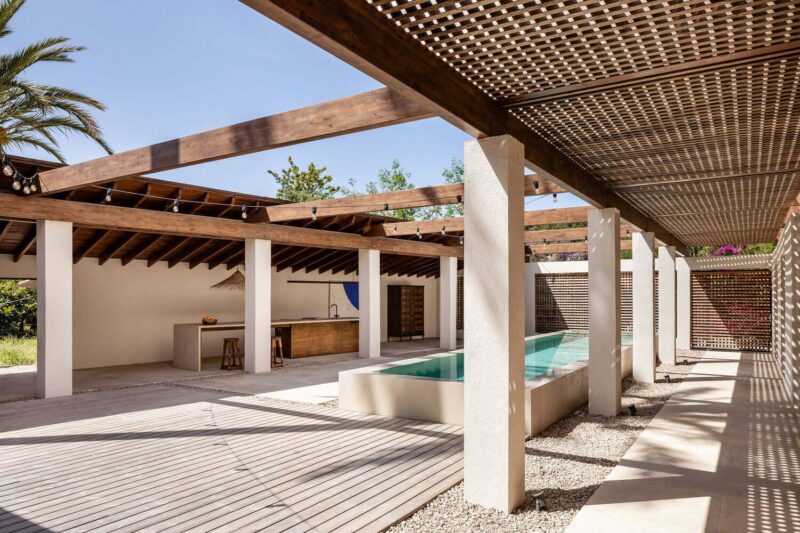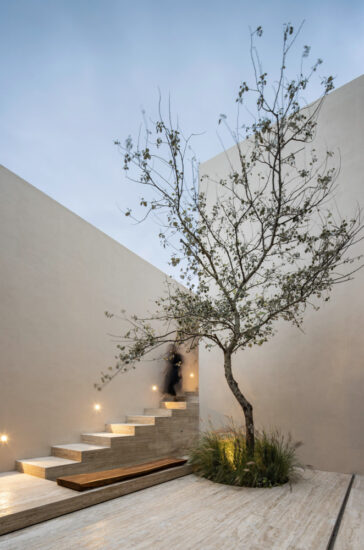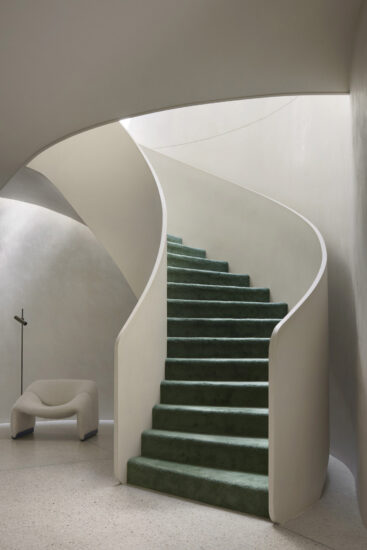LOFT中国感谢来自月介空间的住宅改造项目案例分享:
本项目位于中山,原建筑是90年代由早期国内开发商建造而成。当时开发商并没有太多房产开发经验,以至于落成了一批设计质量较差,同质化明显的产品。设计旨在对原建筑的一种重新诠释,让旧宅得以“重生”。
The project is located in Zhongshan, the original building was built by early domestic developers who did not have much experience in real estate development in 1990s, so that a batch of constructions were built with poor design quality and obvious homogenization. The design aims to reinterpret the original building with intention to rebirth the old house.
住户是三代同堂的一家人。如何将荒废近30年的房子改造成能适应现代生活的新空间是本案的难题。原本建筑格局相对封闭,内部光线昏暗,已不适合当代的居住方式。我们希望整个空间有更多层次,有丰富的弹性空间。
The homeowner is a family of three generations. The difficulty of this case is how to reconstruct the house that has been abandoned for nearly 30 years into a new space to adapt modern life. The original pattern of building is relatively enclosing with inner dimly light, which not for modern lifestyle. We appreciate to have administrative levels and elastic space.
∇ 改造后外观夜景 the night view of the building
建筑设计-建筑的立面设计上,通过重新梳理建筑立面与平面空间使用的逻辑关系,简化原本建筑的繁杂造型。体量感是我们立面设计的首要主题,以深灰色围墙为基础,浅灰色的体块穿插形成独特的入口,强调入口尺度感。从视觉上,白色的建筑体通过与围墙的围合关系形成横向体量感。建筑体上穿插黄色体块使建筑形成生动的立体的构图。
Architectural Design – The façade design of the building simplifies the complex sculting of the original building by reorganizing the logical connection between the building’s façade and the use of planar space. Dimension is the primary theme of our façade design. It bases on a dark grey wall with light grey blocks interspersed to form a unique entrance, emphasizing the scale of entrance. The white building forms a lateral volume through the enclosure with the wall visually. Yellow blocks are embeded to the building forming a vivid three-dimensional composition.
∇ 改造后外观 the view after renovation
设计对于旧建筑并非全部地抹杀,我们依然想保留这个社区和建筑的共性,保留仅存的归属感。设计元素是我们连接旧时和以后的桥梁,而我们选择元素是窗户。我们把旧建筑的窗户归纳出三种类别,分别是圆窗,拱形窗,方形窗。
The design is not completely obliterated for the old buildings, the commonality of this community and architecture would to be preserved, retaining the only sense of belonging. The design element is the bridge to connect the past and the future, while what we choose is window. the windows of the old building were generalized into three categories, namely round windows, arched windows, and square windows.
保留—-旧建筑中3个圆窗作为象征意义的保留下来,作为社区和旧建筑的记忆;
Retainment—-the three round windows in the old building were preserved as symbolic significance, and as memories of the community and old buildings;
∇ 保留-社区记忆 Retention – community memory
再生—-拱形窗作为新建筑的新符号,重新利用渗透到室内外的各个空间;
Regeneration—-arch window is as a new symbol of the new building, re-use each space to penetrate indoors and outdoors;
∇ 再生-元素渗透 Regeneration – elemental penetration
创造—-方形窗则向室外休闲空间的延申造景,创造简约的景观空间。
Creation—-Square window creates a simple landscape space for the extension of outdoor leisure space.
∇ 创造-景观空间 Creation – landscape space
景观空间-建筑所处的街区是相对喧闹吵杂的,建筑筑起围墙的同时,围合出一方天地。围墙内有庭院,有惬意,容纳了生活所需的所有内部空间与交流空间。设计师希望打破建筑内外的分割,让室内与庭院联通,人的活动由室内延伸到室外,室内外创造了连续流动的空间体验。三楼大露台新加建了一间客房,两个房间共享一个景观露台。景观露台并不完全敞开,而是用混凝土形成完整的框架,给人私密感的同时框取了外部景色。
Landscape space – The street where the building is located is relatively noisy, the building is built around the wall as well as is enclosed a private world. There is a courtyard inside the wall, which is cozy and accommodates all the internal space and communication space for life necessity. The designer expects to break the division between the interior and the exterior of the building and connect the interior with the courtyard. Activities extend from indoor to outdoor, creating a continuous flow of space experience both of them. A new room was built on the third floor on the grand terrace, sharing a landscaped terrace between two rooms. The landscaped terrace is not completely opened, but a complete frame is formed using concrete, giving a private feeling while framing the exterior view.
∇ 10庭院空间 ,Courtyard space
室内布局-对原有建筑自身潜力的再利用。在不改变原本建筑结构的基础上,对建筑进行局部加建整理,对建筑内部空间重组整合,形成更加整体简练的建筑空间。并且通过打开了室内空间中不必要的隔墙,打造成了一个充满活力的流动空间,为住户在公共空间中的交流和互动提供了更多的机会。同时重新引导和组织光线,创造出一个自然光和人工照明相交织的明亮空间,营造一种舒适的生活氛围。
Interior layout -the reuse of the original building’s own potential. On the basis of not changing the original building structure, the building is partially built and reorganized, the interior space of the building is reorganized and integrated to form a more holistic and concise building space, it creates a vibrant mobile space that provides more opportunities for residents to communicate and interact in public spaces by opening unnecessary pastitions inside. Redirecting the light to create a bright space interwoven with natural light and artificial light for a comfortable living atmosphere.
原建筑首层客厅比较狭小,设计把车库与客厅打通,形成通透的横厅。
The first-floor living room of the original building is relatively narrow. the design connects the garage and the living room to form a transparent hall.
二层主卧位置为两个套房,设计把两个房间打通。其中一间变成书房,主卧与书房通过半透明的推拉纱门隔断,形成灵活多变的空间形态。
The main bedrooms are two suites on the second floor, which are designed to connect the two rooms. One of them transforms a study. The master bedroom and the study are separated by a translucent sliding screen door to form a flexible and variable spatial form.
完整项目信息
项目名称:90年代旧宅改造
设计公司:月介空间
联系邮箱:mpluslab@126.com
设计年份:201804
完成年份:201901
主创设计:黄卫健 陈秀瑶
技术团队:阮艺强 黄斌
项目地址:中山市火炬开发区
建筑面积:340平方米
摄影版权:kan
品牌/材料:石头漆 石材 玻璃 木地板 瓷砖
Project name:Renovation of old houses in the 1990s
Design: M+LAB
Contact e-mail:mpluslab@126.com
Design year:201804
Completion Year:201901
Design:Weijian Huang / Xiuyao Chen
technical team;Yiqiang Ruan /Bin Huang
Project location: Torch Development Zone, Zhongshan
Gross Built Area: 340m²
Photo credits: Kan
Brands / Products:natural stone coating stone material glass wood floor
ceramic tile


























